|
Here is the article on the history of the Lockheed
Sirius that I electronically scanned from my purchased copy of the April 1973 American Aircraft Modeler
magazine. Patricia T. Groves is the author. All copyrights (if any) are hereby acknowledged.
There were actually two separate articles, one that presented plans and a construction article for
an R/C version of the Lockheed Sirius,
written by Mr. Maurice F. Philips, and the other this history lesson.
Lockheed Sirius History
Many variations of one plywood fuselage were created by Lockheed. The most famous low winger is the
Sirius. PATRICIA T. GROVES After Charles A. Lindbergh entrusted h is beloved Spirit of
St. Louis to the Smithsonian in May 1928, the Mahoney-Ryan 'Company generously replaced it with a brand-new
Brougham B-2. In these and others whose owners or builders were eager to have him demonstrate, Lindbergh
wound up as that year's most conspicuous user of airplanes. With the media reporting nearly every passing
mile, America's No. One aviation booster did extensive personal and goodwill flying while managing to
squeeze in the survey flights he was doing for several air transport companies. Buckled into a wide
variety of airplanes, an outstanding (for 1928) 65,000 miles passed under his wings.
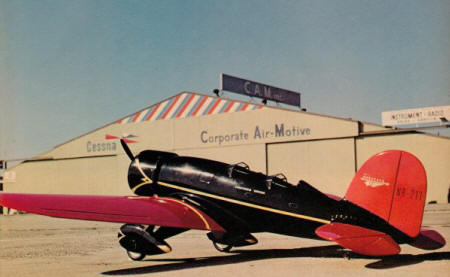
By summer 1929 Lindbergh was actively looking for an airplane of his own choosing that would be
better suited to his current preoccupations. And, when he attended that year's National Air Races in
Cleveland, he was still looking. Also at the August 27th to September 2nd meet was Jerry Vultee, the
saucer-eyed chief engineer for the Detroit Aircraft Corporation's month-old acquisition, the Lockheed
Aircraft Company of Burbank, California. When the two met, Lindbergh mentioned h is search for
a high-performance, long-range plane. While noting the advantages and disadvantages of various configurations,
he stipulated the safety aspects of low-wing, wide-wheel base, quick takeoff and an all-around good
visibility. Then with a current project in mind, Vultee whipped off a few preliminary sketches for Lindbergh
to consider, and made arrangements with the popular flier to meet with Lockheed's new general manager,
Carl Squier, under less hectic conditions than an air show.
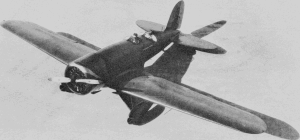 Lockheed Sirius
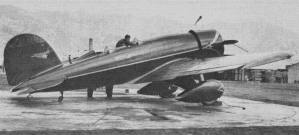 Predecessor to the Sirius
was the Explorer. This plane was developed for transoceanic flights but accidents marred its
success.
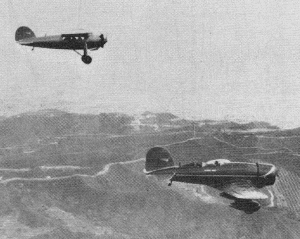 Charles and Anne Lindbergh
in their Sirius are followed by a Vega full of enthusiasts. Note the Vega is an especially early
model.
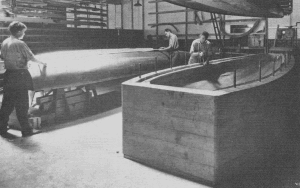 From this concrete mold
built in 1927 came Lockheed's wooden wonders-The Vegas, Air Expresses, Explorers, Siriuses, Altairs,
and Orions-among the great planes of the Golden Age of Aviation.
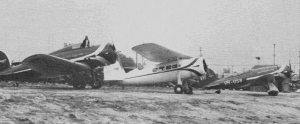 Laura Ingalls emerges from
her record-breaking Orion, near her Harmon-winning Air Express. To the far right is Sir Kingsford-Smith's
beautiful Altair, the Lady Southern Cross.
As it happened, Lindbergh's specifications fit an airplane then being developed in the Lockheed shops.
Earlier that year a young ex-flying service officer named Harold Bromley dropped in looking for an airplane
capable of transpacific flight. The 29-year-old pilot was one of several hardy fliers who hoped to cop
the $25,000 Tokyo Asahi (newspaper) prize for the first non-stop flight (either way) between Japan and
America. With Tacoma, Washington money behind him, Bromley toured West Coast aircraft manufacturers,
including the two-year-old aircraft company in Burbank.At the time, Burbank was an obscure little
burg surrounded by farmland which extended up to the nearby distinctive Verdugo Hills. On an industrial
zoned parcel of ranch land the tall, cone-shaped brick chimneys of the Empire China Company provided
the most distinguishing feature around. The next largest building on the lot was jointly occupied by
the Mission Glass Works and the Lockheed Aircraft Company. Scattered about the patch were several unimpressive
sheds and out-buildings, a ranch house now serving as Lockheed's office and an airplane hangar which
stood alongside an unharried gopher-infested dirt flying strip. At this point Lockheed's advertised
line of aircraft consisted of two model types: A high-wing Vega which was gaining in popularity with
the flying fraternity; a parasol wing Air Express, designed as a mail and passenger carrier.
Bromley walked through the door of the small red brick "office" and into the kitchen cum Lockheed
Engineering Department. Introducing himself to the entire department - Vultee and the company's two
draftsmen, Jimmy Gerschler and Dick Von Hake-the flier laid out his requirements. Later, still discussing
the possibilities, Vultee took Bromley in to meet Allan Loughead, the company's co-founder and general
manager. Afterwards, Bromley toured the plant's wood and metal shops, the as-sembly and service
areas, all yet under the command of Tony Stadlman, another of the company's originators. While activity
was apparent, it was hardly a high pressure operation. During the tour Bromley spied an unfinished
fuselage stuck off in an out-of-the-way corner. Looking as though it had been cut out to accommodate
a lower wing, he asked about it and was told that it was a relic of an experiment begun by Jack Northrop
in the "old" Hollywood plant back in '27. The begin-nings of a low-wing job for Hubert Wilkins, the
project was abandoned when the Wilkins group unexpectedly ran out of money. Then momentarily considered
the following year as a sea-plane, it was hauled out only to be shoved aside again. Although designated
an Explorer, there'd been little or no engineering done on it. And "thar she set" until Bromley walked
in. To Bromley the altered Vega fuse-lage had possibilities. And over the fol-lowing weeks he,
Vultee, Gerschler and Von Hake finished off the engineering. (More custom-built than mass produced,
buyers of Lockheed airplanes, like ex-pectant fathers, labored alongside the production crews.) By June
18, 1929 the first Lockheed Explorer rolled off the line with a low wing-extra long, broad and straight
with no dihedral. (Basic fuselage construction was the same as with the Vega. See August 1970 American
Aircraft Modeler, page 16ft.) A single-seat open cockpit was placed just forward the empennage which
had undergone several cut-and-dry design Changes. The tail unit at this point having a rounded fin and
a squared-off rudder. Flight tests proved satisfying, and Bromley flew home to Tacoma to begin his dash
across the complacent Pacific. On Sunday, July 18, 1929, the big Explorer, its latent power
buried under garlands of flowers, was christened the City of Tacoma by two little girls representing
the U.S. and Japan. Finally, cheers of thousands ringing in his ears, the young airman shoved the throttle
to the firewall to begin his run. Within seconds cheers turned to screaming pan-demonium as the glistening
orange Explorer wobbled into the air-then crashed. Overlooked in the joyous frenzy of the day,
the fuel-topped off to capac-ity in the early morning hours -expended as the sun rose higher in the
summer sky. When Bromley made his run, it slopped over in his face and blinded him. The aviator tried
desper-ately to recover, but couldn't. Barely before impact Bromley managed to flick off power, thereby
preventing a fire and saving his life plus those of the panicky spectators running toward him.
Still willing to back his efforts, the Tacoma group put up new financing, and Bromley returned to
Burbank with enough salvage to mother-hen a second City of Tacoma. (Although Lockheed now was under
Detroit's command, the same easy-going atmosphere prevailed.) Bromley and Vultee worked out several
new changes to the second Explorer; however, this aircraft, too, came to grief. Subsequently, a third
City of Tacoma was laid up incorporating engineering modifications that had come about as a result of
the recent Lindbergh order. The requirements of the Lindbergh aircraft had evolved enough, by
now, to designate the new model name of Sirius. The same length as the Explorer, the Sirius, however,
had a slightly shorter more slender wing with two degrees dihedral built in. Two single-seat open cockpits
tandem were placed forward a classically high rounded tail which added a foot to overall height. Fitted
with a 450 hp Pratt & Whitney Wasp, wheel pants and the NACA cowl, the airplane was painted in the
high-contrast colors of black and orange. Typically, Lindbergh was on hand every possible moment
during the building of the Sirius. Then in January 1930, after testing by Lockheed pilot Marshall Headle,
Lindbergh accepted it. Introducing the 2974-lb. bird to his petite wife Anne, the three got acquainted.
Over the next four years, the Lindberghs and their Sirius were seen all over the world. And, although
these survey flights presented some of their most demanding work, their flying missions together provided
the couple their most precious moments of privacy. At this point In their lives the big Lockheed was
a second home and sanctuary. During 1934 the Sirius, by now known as the Tingmissartog, was
donated to the American Museum of Natural History. When it later moved to the Smithsonian, the Tingmissartog
- registered NR-211-joined the Spirit of St. Louis - registered NX-211. The following year Lindbergh's
sentimental attachment for the 211 N-number was then transferred to a Lamberg 0-145 Monocoupe which
he kept for about six years before donating it to the Missouri Historical Society. Although it never
participated in any particularly note-worthy flight and he wasn't overly fond of it, Lindbergh donated
it to assure the preservation of a type of small aircraft constructed in St. Louis during the Thirties.
Referred to by him as "the Lambert," it's now on display at the National Museum of Transport in St.
Louis. Ultimately, 14 of the wooden Sirius were built more or less along the same lines as Lindbergh's
model 8. A fif-teenth was built in Detroit using an ex-perimental all-metal fuselage. Twin cockpits
tandem provide the most noticeable difference between the Sirius and the single-seat Explorer. Sliding
canopies added to the Lindbergh aircraft after a few month's trial became a standard accessory in all
Sirius models. The slightly heavier Sirius 8A differed from the original 8 in having a larger fin and
rudder area and an additional four in. added to the fuselage length. One aircraft in the 8A series was
fitted with Lockheed's first fully retractable landing gear. Originally intended for the Lindbergh Sirius,
the prototype gear turned out too wimpy. By the time the necessarily re-engineered wing (which later
evolved Into the Altair model Lockheed) was ready, Lindbergh had al-ready exchanged the standard gear
for Edo floats. Construction Of the Sirius C was typical of the methods of the day where each
individual Lockheed was an indi-vidual built to individual specifications. The C differed in that forward
the cock-pits, a close two-seat cabin was included. Nearly a year later the easily adaptable
fuselage was again re-engineered into an air transport progression. First referred to as a Sirius six-passenger
cabin plane, as the designs altered, the name was changed to Altair Model 9 be-fore it too progressed
enough to merit its own model name-type of Orion. By making optimum use of the one basic design,
Lockheed's 30-ton concrete mold turned out the distinctive, easily identifiable Vega, Air Express, Explorer,
Sirius, Altair and Orion. With nearly every aircraft altered and changed, adapted and modified, stripped
down or jazzed up to suit the requirements of their owners, each wooden Lockheed was an individual in
an era of individuals.
Posted June 16, 2010
|